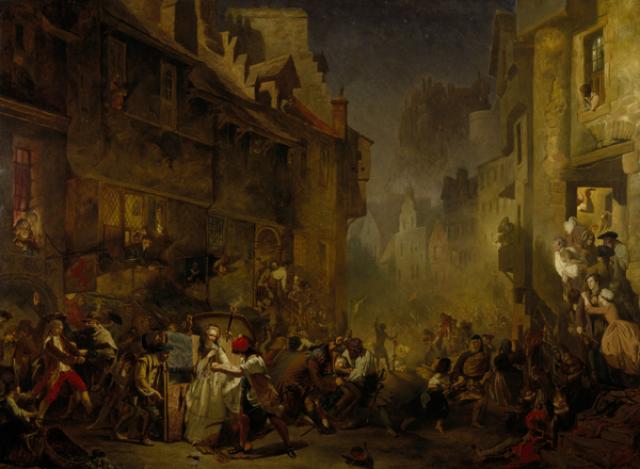History painting
A term used to refer to images of important or memorable episodes from literary, historical or religious sources. These works are often large-scale and include complex arrangements of figures and objects in a landscape or architectural setting. Historically, it was revered as the highest form of painting.

Origins
History Painting developed in Renaissance Italy when artists used Classical texts to justify the status of painting as a noble art form, as distinct from craft work. For example, Aristotle was quoted as stating ‘human nature in action is the proper sphere of both painters and poets.’ (Poetics II.1) The figures in such paintings were deliberately idealised to suggest strength and virtue as in Titian’s Poesie based on Ovid’s Metamorphosis. These works were also often characterised by the number and scale of figures, a well-ordered and balanced composition with a clear narrative and refined colouring.
Key Concepts
Most often, the subject or story of a History Paintings is a significant event derived from a written source. It can be accepted as historical fact, or mythological or allegorical in nature. This is not restricted to religious or classical themes but can include events from the more recent past, sometimes presented as a scene from classical history, such as Gavin Hamilton’s James Dawkins and Robert Wood Discovering the Ruins of Palmyra, 1758.
What distinguished History Painting from other multi-figure compositions such as genre painting, was its scale, careful compositional arrangement, sophisticated use of colour, and the use of gesture - often modeled on Classical sculpture to convey the significance of the occasion being painted. Peter Paul Rubens (1577-1640), Nicolas Poussin (1594-1665), and Giovanni Francesco Barbieri (better known as Guercino, 1591-1666) were key proponents of the genre. It was seen as the most challenging and intellectual type of painting, mainly as it relied on a thorough knowledge of a variety of textual sources in order to be able to understand or ‘read’ the image.
Continuing Development
In the seventeenth century, the dignified grandeur of History Paintings showing Classical subjects was applied to more recent history. In this way, allegorical figures could be painted alongside near contemporary figures in order to glorify the protagonists and present their achievements as akin to heroes of the past. The Baroque style also led to History Painting becoming more epic in scale and composition. These works were often more complex with multiple figures, rich detail and exaggerated gestures, such as Benjamin West’s huge painting of Alexander III of Scotland Rescued from the Fury of a Stag by the Intrepidity of Colin Fitzgerald ('The Death of the Stag'), 1786.
History Painting in the Grand Manner was structured in the teaching and practice of the Académie Royale de Peinture et de Sculpture in Paris. It was held as the highest art form above landscape, portraiture, and still-life. However, changes in taste and patronage would challenge the supremacy of History Painting in this strict hierarchy of genres. Indeed, the Rococo style exemplified by the work of French artists Jean-Antoine Watteau (1684 - 1721) and Francois Boucher (1703 - 1770) with their focus on pleasure and prettiness, was incongruous with the seriousness and formality of History Painting.
It would come to have renewed significance in the second half of the eighteenth century with the emergence of the Neo-Classical style. The popularity of the Grand Tour increased interest in Classical Antiquity and the work of the Old Masters. The belief that these works represented the highest form of culture led to the appropriation of History Painting to covey nationalistic sentiment. Contemporary events were shown in the History Painting format in order to suggest that they now enjoyed the same legendary status, such as Théodore Géricault’s famous The Raft of the Medusa, 1818-19.
Decline
In the nineteenth century, medieval and ancient histories began to be considered suitable subjects for History Paintings. Again this was often linked to nationalistic fervor and the search for a collected National past. However, at the close of the century, ensuing progressive art movements rejected History Painting, instead favoring more honest instances of everyday life. This decline would continue into the twentieth century with only a few notable exceptions when the gravitas of History Painting was evoked in large-scale, multi-figure compositions designed to confront the communal consciousness.












